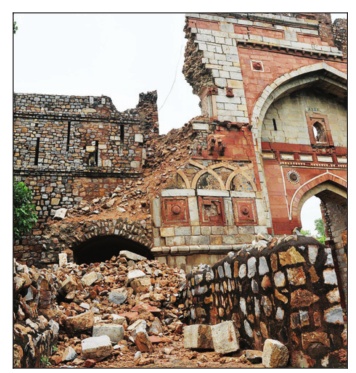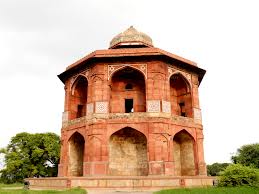Delhi: Purana Quila (Old Fort)
This article was written between 1902 when conditions were Readers will be able to edit existing articles and post new articles |
Contents |
Delhi: Purana Quila (Old Fort)
Extracted from:
Delhi: Past And Present
By H. C. Fanshawe, C.S.I.
Bengal Civil Service, Retired;
Late Chief Secretary To The Punjab Government,
And Commissioner Of The Delhi Division
John Murray, London. I9o2.
NOTE: While reading please keep in mind that all articles in this series have been scanned from a book. Therefore, footnotes have got inserted into the main text of the article, interrupting the flow. Readers who spot these footnotes gone astray might like to shift them to the correct place.
Secondly, kindly ignore all references to page numbers, because they refer to the physical, printed book.
Extract begins
The extremely picturesque walls of the Purana Kila come into full view, and after passing along the north-west side of these, and, on the right, the second city gate above noticed, a road turns to the left and leads to the bridge in front of the south gateway of the Fortress.
Opposite the point of junction of the two roads is a fine enclosure with a handsome portal of red sandstone, and a large mosque, known as the Khair-ul-Manazil (the Auspicious of Houses), or Lal Chauk (Red Enclosure). This was built in 1561 A.D. by Máham Anagah, the foster-mother of the Emperor Akbar, and mother of Adham Khan from it a few years later an attempt was made by an archer to assassinate the Emperor.
The Purana Kila was constructed on the site of the historical Indrapat—one of the five villages 1 over which the war celebrated in the “Ramayana” {??? Perhaps The Mahabharat is meant} was waged—by the Emperor’s Sher Shah and Humayun. [1 These five were Panipat, Sonpat, Baghpat, Indrapat, and Tilpat.]
The historian who describes its phenomenally rapid completion, under the designation of Din Panah, to the latter before his expulsion by the former, was probably more courtly than truthful, and it is practically certain that the present walls and gates and the buildings which they surround are the work of the Pathan Usurper and his successors. The lofty south gate will probably be considered as effective as any of the buildings of Delhi previous to 1640 A.D.—the decoration on it is very pleasing.
From the gate a lane leads northwards to the back of the Mosque of Sher Shah, and the Sher Mandal near it. The facade of the former is quite the most striking bit of coloured decoration at Delhi, and has been satisfactorily restored. The red sandstone used in it is of an unusually deep tone, and very beautiful. The brackets under the balconies are an early type of those which are so marked in the red sandstone palace of Akbar or Jehangir in the Agra Fort.
The interior is extremely fine, the patterns in the pendentives below the dome being very effective. The Sher Mandal is interesting as the building on the steps of which the Emperor Humayun slipped when rising from evening prayer, and met with his death in 1556 A. D. The date of his death is embodied m the anagram : “Humáyun Badshah az bám uftad” (“King Humáyun fell from the roof”), but this does not really give the exact date.
Proceeding down the road from the Purana Kila to Humayun’s Tomb, there is seen first on the left a lofty Kos Minara,2 or milestone, and then on the right the picturesque tombs, known as the Lal Bangala built by the Emperor Shah Alam II., and named after his mother, and on the left again an octagonal tomb, once covered with fine encaustic work, called the Nili Chhatri, or Blue Tomb, of Naubat Khan, an Amir of the Court of Akbar. [2 These milestones were placed in the centre of the old royal high roads radiating from Delhi to the Provinces, and many still exist along these. Another very complete one stands opposite the entrance of the Mubarik Bagh According to Sir Henry Elliott, measurements of the distances between nearly twenty of them near Delhi showed they were placed just two and a half miles apart, so that the kos they marked was what is known as the double kos.]
The channel connecting the Western Jumna and Agra canals runs parallel to the right of the road here, and at three and a quarter miles from the Delhi gate, where a fine tomb, known from the colour of its dome as the Sabz Posh, or Green Top, one route diverges across the canal to the Dargah of Nizam-ud-din-Aulia, and another leads on the left to the Mausoleum of Humayun, the second great Moghal Emperor. In approaching this, the road passes under the picturesque bright kiosks of the walls of the Bu Halima garden, first admitting of a view of the tomb of Isa Khan and then turns left again at the gate of the garden and the very handsome gateway of Arab Sarai to the portal leading into the garden round the mausoleum.
The wings of this are thrown forward, and standing as it does at the top of a fine flight of steps, it forms a worthy approach to the tomb. It was into this portal that Captain Hodson rode on 22nd September 1857, and called upon the retainers of the Delhi Princes to surrender their arms
The trees which formerly hid the mausoleum too much have been cut back, and the building is now fully seen rising finely from a lofty platform under its great dome of white marble. In mere beauty it cannot of course compare with the Taj, but there is an effect of strength about it which becomes the last resting-place of a Moghal warrior whose life was marked by many struggles and vicissitudes, and most people will probably prefer its greater simplicity to either the son’s tomb at Sikandra, near Agra, or the grandson’s tomb at Shahdara, near Lahore.
The ground plan of the tomb is peculiar, as the angles project beyond the central bay on each side, and the freer use of white marble on them adds to the prominence of their position. The decoration of white and grey marble and of fawn-coloured stone on the red sandstone is very effective, and the pierced marble screens in the openings to the interior are among the very finest specimens of this work.
The railing on the edge of the platform has recently been restored all round it, much to the improvement of the general effect. The interior is entered from the south side, and the actual vault can also be visited from the lower terrace on this side. The central chamber, which is a very fine and lofty one, contains only the marble tomb of the Emperor His faithful wife, known as Haji Begam, who built the tomb and Arab Sarai, is buried in the north-east corner of the building.
The other corner rooms also contain graves, which are nameless, but are known to include those of the unfortunate Dara Shekoh, of two of the brothers of Shah Alam Bahadur Shah, who fought against him for the Empire, and three sons of these, and of the Emperors Jahandar Shah and Alamgir II. (d. 1712 and 1761 A.D.)
The Emperor Jehangir records in his memoirs that while in pursuit of his son, Prince Khusru, he visited the tomb of his grandfather, and distributed alms at it and at the tomb of Nizam-ud-din-Aulia, to which also he went. He would doubtless have appreciated the scene in which his father is represented with Shah Tahmasp in the hall of the Chihal Situn (Forty Pillars) at Isfahan, of which the account given in the note below will perhaps be found interesting.1
On the top of the building, round the drum below the dome, are a number of rooms and pavilions, once occupied by a college attached to the mausoleum, and reminding one of the colony of St Peter’s dome. The view from the top is extremely fine, and includes nearly everything of interest round Delhi, except Tughlakabad, hid by rising ground to the south. The fine mass of trees on the further bank of the river marks Patparganj and the site of the battle-field of Delhi in 1803
Nili Burj
In the south-east corner of the garden is a nameless picturesque tomb of red sandstone, with some beautiful pierced grilles in the windows, and outside, in the same direction, is the Nili Burj [neeli burj, the blue dome]. This tomb, with its beautiful dark blue dome, is that of Fahim Khan, and was, it is believed, erected to his memory about 1625 A. D., by the Khan-i-Khanan, in whose cause he fought and fell.
The large tomb of this chief, son of the great Turk noble Bairam Khan, who won back the Moghal Empire for Humayun at Sirhind and for Akbar at Panipat, and rebelled against the latter, is also seen from the top of the mausoleum. It must once have been an extremely beautiful structure, but it was stripped of most of its marble by the Nawab Wazir of Oudh, Asaf-ud-daulah, and is now only a grand ruin of red sandstone—the centre bays of the sides are particularly fine.
The gate which led to the enclosure of this tomb stands on the east side of the Grand Trunk Road, and both can be reached by proceeding half a mile down this from the Sabz Posh Tomb. Khan Khanan himself was Governor of Gujrat and the Punjab, and fought one of the most desperate battles waged with the Bijapur power. A few hundred yards beyond these is the old Moghal bridge, known as the Barah Palah, or Twelve-Arched, which is decidedly picturesque, as viewed from down stream, and well deserves a visit.
This bridge was crossed by Mr William Finch in his journey from Agra to Lahore. “The city of Delly” (that is, the Delly of Sher Shah, whom Finch calls Salim), he writes, “lies in a delightful plain, compassed with curious gardens and monuments.
It is a matter of two cose (kos) in length from gate to gate, and has the fate of a great many other noble cities of India, to lie partly in ruines. . . . . The ruines of old Delly (i.e. Kila Rai Pithora, Jahanpanah, Siri, and Tughlakabad) lie a little distance from here, separated by an arm of the Gemini (Jumna), over which is a bridge of eleven or twelve arches. . . . . Particularly there appears amongst these ruines the carkase of that ancient building called the castle, that had to the number of 52 gates (this is Tughlakabad, a thing of surprising glory and stateliness in its time, hot now worn out and disfigured to the last degree.
Mr Finch noted quite correctly that there were four Old Delhis, one of Sher Shah and three built by the Pathan Kings, viz., the original Delhi, with its extensions of Jahanpanah and Siri, Tughlakabad, and Firozabad.
Outside the north-east corner of the garden of Humayun’s tomb are the remains of a house and a mosque in the severe middle Pathan style, which, according to credible tradition, formed the residence of Shekh Nizam-ud-din-Aulia.
To the east side of the gateway leading into Arab Sarai are two pleasing buildings, known merely as the Afsarwalla (Afsar means crown, as well as officer) mosque and tomb. The graceful proportions of this gateway, and the handsome balcony above it, are noticeable. Fifty yards inside it a lane leads to the right to the tomb and mosque of Isa Khan, which should be visited, especially if those of Khairpur cannot be Isa Khan was a leading noble of the times of Sher Shah and his sons, and was buried here in 1547 A.D.
The structures are similar to those of the Syad and Lodi Kings, and were once profusely decorated with encaustic tiles. The octagonal tomb, with its raised outer gallery and pavilions round the dome, is specially picturesque.
Excavations
2014
A challenge to conserve deposits
Anuja Jaiswal, Sep 24, 2022: The Times of India

From: Anuja Jaiswal, Sep 24, 2022: The Times of India
New Delhi : Even after eight years, the Archaeological Survey of India has failed to conserve and preserve the cultural deposits of the last 2,500 years found during the excavation at Purana Qila, which is the only site in Delhi to showcase the cultural continuity from pre-Mauryan age to the Mughal era.
The shade that was supposed to have been constructed to protect the relics while exhibiting them is yet to be finalised.
After the excavations in 2014, ASI officials had planned to cover the site with a roof and showcase it to the public with proper signage and maps alongside an interpretation centre that would explain the history of the city and the context of the site spanning nine historical eras. However, the infrastructure is not yet in place and ASI is still only in the process of finalising the shade design.
Vasant Swarnkar, director and spokesperson, ASI, agreed that it had indeed been proposed that the outcome of the 2014 excavations be opened up for the public after a proper covering of the site was erected. “Efforts are still being made to reopen the excavation site and to providesheds over the excavated area,” he said, adding that these excavations will be conserved with the help of old drawings and photographs from ASI archives. As of now, trenches are filled up with soil to protect the ancient structures. Three excavations have been carried out in Purana Qila in the last 60 years.
Among artifacts recovered have been terracotta beads and toys of the Mauryan period, terracottaYakshi figurine of the Sunga era, terracotta votive tank and copper coins of the Kushan age, seals and coins of the Gupta period, different types of beads of coral, crystal and carnelian, glazed plates and coins of from the Sultanate years and Chinese porcelain with Chinese inscription, glass wine bottles and a gold earring from the Mughal period. The first excavation was carried out in 1954-55 by renowned archaeologist BB Lal, who died earlier this month.
He had unearthed traces of painted grey ware culture under the mound. On the basis of this, Lal had claimed that Purana Qila was part of the Pandava kingdom of Indraprastha and estimated the war recounted in the epics to have occurred in 900 BCE.
During the excavation in 2014, traces of painted grey ware were found, and another dig in 2017 confirmed the existence of a preMauryan link of the site to the Iron Age.
2023
Anuja Jaiswal, June 28, 2023: The Times of India
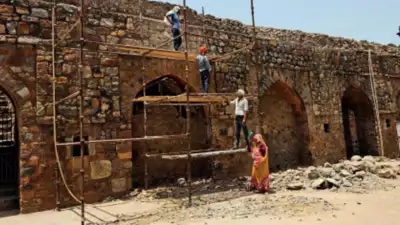
From: Anuja Jaiswal, June 28, 2023: The Times of India
NEW DELHI: In a case of negligence, ASI's failure to protect the excavated remains of the historical legacy spanning over 2,500 years at Purana Qilahas resulted in extensive rain-water damage to several sites. According to sources, temporary arrangements such as tarpaulins failed to protect the sites and several remains, including the unburnt bricks of the Kushana period, were damaged due to rainwater.
Vasant Swarnkar, project director and spokesperson of ASI, told TOI that work to put up sheds at the site was under process. He claimed that necessary precautions had been taken by covering the sites with tarpaulin sheets, but some water had dripped in.
When contacted, superintendent archeologist (Delhi circle) Praveen Singh said the installation of sheds at the site had been proposed, but it could not be said when the work for the same would start as the process is yet to begin.
This has happened despite Union minister of culture G Kishan Reddy's recent announcement about protecting these sites. On May 30, the minister had said, "The excavated remains will be preserved, conserved and provided with a shed. The site will be showcased as an open-air site museum, allowing visitors to experience the historical legacy of Delhi.”
A visitor, Shyamlal Gupta, who went to the site on Monday, said this one-of-a-kind site had witnessed the history of over 2,500 years but ASI was not taking any interest in protecting it. How will they showcase the site if it's damaged, he questioned.
ASI officials had earlier claimed that the excavated remains at Purana Qila would serve as a point of attraction to the delegates of the G20 Summit scheduled to be held in Delhi in September. However, no significant protection from the weather has been provided to the site.
Purana Qila has witnessed multiple excavations in the past. Notably, professor B B Lal conducted excavations in 1955 and between 1969-73, followed by excavations led by Swarnkar in 2013-14 and 2017-18. These efforts have revealed nine cultural levels, representing different historical periods, including Pre-Mauryan, Mauryan, Sunga, Kushan, Gupta, Post Gupta, Rajput, Sultanate and Mughal.
Details
Anuja Jaiswal, May 30, 2023: The Times of India
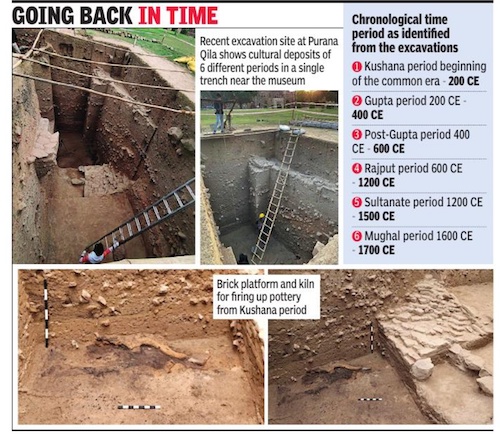
From: Anuja Jaiswal, May 30, 2023: The Times of India
New Delhi : In a rare find, the ongoing excavation at Purana Qila has unearthed a unique “six-fold” cultural sequence from the Kushan to the Mughal periods without any break in a single vertical trench.
The recent excavations near the museum on the premises have revealed the continuation of 2,000-year-old habitations at one site in a vertical manner and more evidence of the Kushan period with the unearthing of a 2,000-year-old brick platform and a kiln for firing potteries. The discoveries were made after digging 5. 5-meter deep from the surface near the museum. The director and project in-charge at Archaeological Survey of India (ASI), Vasant Swarnkar, told TOI that the objective of the excavation was to expose the chronology of the site in a vertical manner so that one could see the continuous habitational deposits at one place to understand the ancient cultural history of Delhi. During previous excavations, different cultures were exposed in several trenches. The excavations were undertaken to discover the extension of habitations of lower levels — Kushan, Shunga and Maurya periods. “Sampling of a few charred grains identified as wheat and lentils have also been found from Rajput, Gupta and Kushan levels,” he said, adding that the area was excavated to know the cultural deposit from the highest point of the mound. The digging has brought to light a wall built of rubble stone and brick-bats with mud mortar of the Rajput period. The excavations conducted in 2017-18 had confirmed the earliest time periods of habitation in the city of Delhi at the site of Purana Qila, identified as Indraprastha by historian and professor BB Lal. The objectives of this excavation was to unearth evidence of the painted grey ware culture in a stratified deposit, expose the structures of various cultural levels to conserve them for visitors, and collect fresh samples for both relative and absolute dating.
The maximum depth excavated in the last two excavations in 2013-14 and 2017-18 of habitational deposits, including a slope, were 12. 3-13 meters at the site. However, only a 5. 5-meter-deep area has been dug up in the recent excavation. Archaeologists said that during previous excavations, a house complex of the Kushan period, consisting of at least three rooms, was unearthed. While in the Gupta period, Kushan bricks were seen to have been re-used for construction of structures and among the antiquities, terracotta ceilings were significant findings, one with the mention of “Brahmavarta” in Sanskrit.
Potteries of the post-Gupta period include fragments of sprinklers with prominently flanged rim below the long conical opening and a spout, sharp-edged rim bowls, horizontally splayedout rim vases, chequer-patterned impressed pottery, mica dust slip decoration with bonbon design, etc. A stone wall of semi-dressed stone of size 4. 40m x 1. 4m x 1m was exposed in phase III of the Rajput Period. The unusual width of the wall indicates possible fortification during the Rajput period.
Three random rubble stone walls of phase II of the Sultanate period were also found. The antiquities of this period consist of stone weights, architectural members of stone, stone pestle etc. “The Mughal period is represented by the porcelain ware pottery, found in little quantities of tiny pieces of blue and white porcelain. Besides these, an important finding of this year, since the excavation resumed at the site, is a terracotta human head,” said Swarankar.
2023: rains wash away excavated sites of ancient
Anuja Jaiswal, June 28, 2023: The Times of India
NEW DELHI: In a case of sheer negligence, Archaeological Survey of India's failure to protect the excavated remains of the historical legacy spanning over 2,500 years at Purana Qila has resulted in extensive rain water damage to several structures.
According to sources, temporary arrangements such as tarpaulins failed to protect the excavated sites and several remains were damaged. Unburnt bricks of the Kushana period were dissolved by rain water.
Vasant Swarnkar, project director and spokesperson of ASI, told TOI that work to put up sheds at the site was under process. He claimed that necessary precautions had been taken by covering the sites with tarpaulin sheets, but some water had dripped in.
When contacted, superintendent archeologist (Delhi circle) Praveen Singh said the installation of sheds at the site had been proposed, but it could not be said when the work for the same would start as the process is yet to begin.
This has happened despite Union minister of culture G Kishan Reddy's recent announcement about protecting these sites. On May 30, the minister had said, "The excavated remains will be preserved, conserved and provided with a shed. The site will be showcased as an open-air site museum, allowing visitors to experience the historical legacy of Delhi."
A visitor, Shyamlal Gupta, who went to the site on Monday, said this one-of-a-kind site had witnessed the history of over 2,500 years but ASI was not taking any interest in protecting it. How will they showcase the site if it's damaged, he questioned.
ASI officials had earlier claimed that the excavated remains at Purana Qila would serve as a point of attraction to the delegates of the G20 Summit scheduled to be held in Delhi in September. However, no significant protection from the weather has been provided to the site.
Purana Qila has witnessed multiple excavations in the past. Notably, professor B B Lal conducted excavations in 1955 and between 1969-73, followed by excavations led by Swarnkar in 2013-14 and 2017-18. These efforts have revealed nine cultural levels, representing different historical periods, including Pre-Mauryan, Mauryan, Sunga, Kushan, Gupta, Post Gupta, Rajput, Sultanate and Mughal.
2000 year old artefacts
Anuja Jaiswal, Sep 7, 2023: The Times of India
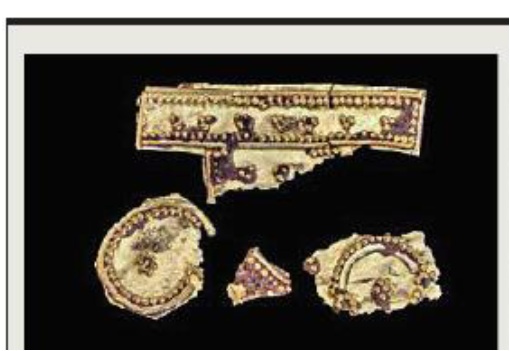
From: Anuja Jaiswal, Sep 7, 2023: The Times of India
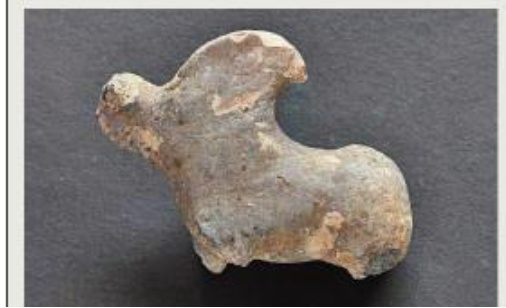
From: Anuja Jaiswal, Sep 7, 2023: The Times of India
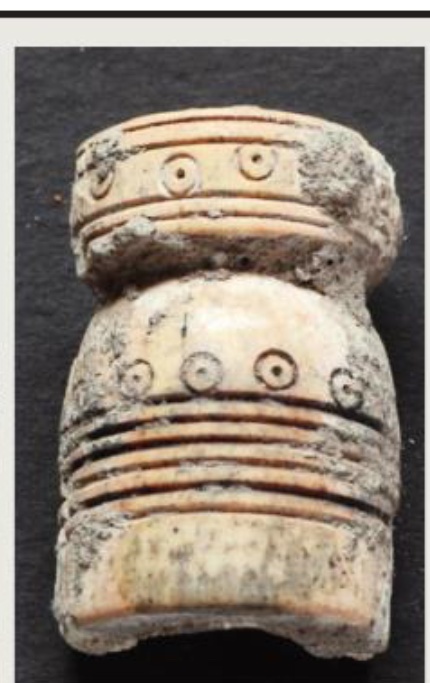
From: Anuja Jaiswal, Sep 7, 2023: The Times of India
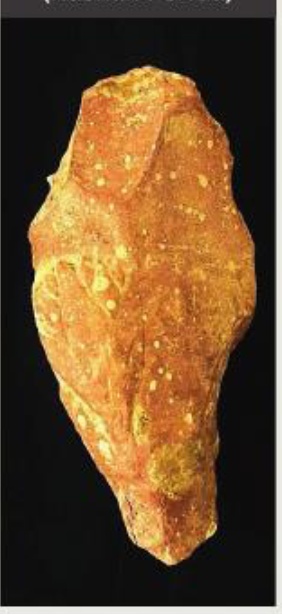
From: Anuja Jaiswal, Sep 7, 2023: The Times of India
New Delhi : A 2,000-year-old decorated “gold foil” embedded in a wooden object and an engraved “lotus” symbol on a piece of red sandstone, dating to the Kushan period, have been found during the ongoing excavations at Purana Qila.
Experts believe that the findings indicate that an “elite” class of citizens were staying there. Besides, evidence of a big kiln and a huge brick platform was also found, indicating major activities there.
Excavators said that the latest excavations have led to the discovery of several significant structures of the Kushan period, including a brick platform and potter’s kiln — an extensive area showing half-made and full pots, evidence of certain well-fired pots, and support of brick elements inside the potter’s kiln; a stone wall, and a cell of mud-brick walls along with numerous post holes and a rammed brick floor. A typical feature of the Gupta period, a 1,500-yearold brick jelly floor has also been unearthed.
Giving detailed information of latest findings of antiquities of Kushan period, the project director of Purana Qila excavations and director (archaeology), ASI, Vasant K Swarnkar, said, a tortoise shaped amulet, ivory amulet, terracotta plaque of female, animal figurines, a ram with stamped designs, seals, microbeads, jade be ads, shell objects, copper chisel, part of votive tank, bone needle, anthropomorphic pot, coin mould, and parts of temple structural elements and copper coins were found. He added that arrowheads and spearheads of the Kushan period too were found during the excavation.
“The latest findings are related to the excavation at the centre of the Qila, while previous findings were at the corner or at the edge of the boundary line of the fort,” he said.
ASI spokesperson TJ Alone said that the other findings included seals and coins, terracotta animal figurines of a bull and several beautifully ornamented human figurines, different types of beads of coral, crystal, agate (the banded variety of chalcedony, which comes in a wide variety of colours) and carnelian (commonly used as a semiprecious stone), dices and iron and copper implements, along with arrowhead and copper and terracotta wheels dating to the Gupta period (5th and 6th century). The earlier excavations had revealed a divinely sculpted image of Vaikuntha Vishnu (Rajput period), an exquisitely carved terracotta plaque of Gaja-Lakshmi (Gupta Period), a small image of lord Ganesha in soapstone (Mughal period) and ring-well of Mauryan period.
Purana Qila, popularly known as Pandavon ka qila, stands on a mound of nearly 710 metres in length north west and 350 m east-west and of about 2 km periphery which may possibly mark the site of the town of Indraprastha (time period of Mahabharata). Inscriptions like Chandrawati copper plate writing, Naraina stone inscription, and Sarban stone inscription, the Ashokan rock edict of Bahapur, and in literature, such as Mahabharata, and the Jatakas, etc., have provided evidence of the location and history of the ancient city of Indraprastha.
The excavations here have provided evidence to the fact that Delhi has a continuous history for almost 3,000 years.
Excavations are further on to understand the complete chronology of this significant archaeological site.
Gallery of confiscated and retrieved antiquities
Estd. 2019
Anam Ajmal, September 1, 2019: The Times of India
History lovers have something to look forward to when they visit the 16th-century Purana Qila next. Its arched cells now hold a treasure trove of antiquities that were either seized while being smuggled out or returned to India by foreign governments.
On Saturday, minister of state for culture and tourism, Prahlad Singh Patel, inaugurated the ‘gallery of confiscated and retrieved antiquities’ that showcases artefacts dating from the second century BC to 19th century AD.
The 195 antiquities on display are an extension of the central antiquity collection (CAC) and includes stone and metal sculptures, coins, paintings, ivory and copper artefacts. CAC has a total of 2,72,824 antiquities of which 4,144 were either confiscated or retrieved by ministry of external affairs, and several law enforcing agencies like police, CBI, Customs and directorate of revenue intelligence.
Archaeological Survey of India says it has retrieved 44 stolen antiquities from countries like the US, Australia, Singapore, Germany, Canada and the UK so far. Of these, 31 were retrieved in the last five years. “Ten of these artefacts are displayed at the new gallery, and the central agency is in the process to get 119 more antiquities back to the country,” said ASI assistant superintending archaeologist Archana Asthana.
“These artefacts represent our country’s cultural heritage. And it proves and glorifies our rich history spanning thousands of years. This is proof that our ancestors created and cherished art forms,” said minister Patel, while crediting the retrieval of the artefacts to India’s “improved foreign relations”. New Delhi MP Meenakshi Lekhi, while praising the law enforcing agencies, urged the government to make laws and policies that facilitate the return of such art pieces so that India can return to her former glory.
The gallery, which silently represents India’s composite culture through the ages,
Piyal Bhattacharjee houses several coins issued by kings of the Kushan period displayed next to those issued by kings of the Sur dynasty. The ivory sculpture collection dating between 17th and 19th centuries showcases two fist-sized statues of Mother Mary and a Christian saint, right next to the Indian goddess referred to as Devi.
Some of the highlights of this one of a kind gallery includes a standing Buddha from the 6-7 century that was originally discovered in Bodh Gaya. It went missing between 1987 and 1989 and was later found displayed at the Metropolitan Museum of Art in New York. After an inquiry, the MMA returned the sculpture in 1997.
A bronze statue of Sridevi (12-13 century) from the Chola dynasty is also displayed at the gallery. The statue, originally from Tamil Nadu, was smuggled out of the country by antiquities dealer Subhash Kapoor. It was later seized by US authorities and returned to India in June 2016.
A marble idol of Brahma-Brahmini stolen from Gujarat’s Rani ki Vav in 2001, is also on display. It was returned to India in 2017.
The gallery will remain open for public from 10am to 5pm on all days except Friday.
Lake
2018: poor condition
Jayashree Nandi, Purana Qila lake may lose recharge capacity, June 20, 2018: The Times of India

From: Jayashree Nandi, Purana Qila lake may lose recharge capacity, June 20, 2018: The Times of India
Delhi’s groundwater resources are fast depleting and many parts are already suffering from indiscriminate withdrawal that may take years to replenish. Yet, agencies are considering lining or concretising the base of the moat lake at Purana Qila to ensure that there is water all year round.
The Archaeological Survey of India, following a National Green Tribunal order, has started restoring the moat and outsourced the work to the National Building Construction Corporation.
But, recently, Yamuna Jiye Abhiyan found that a part of the plan is also to concretise the water body and fill it up with water from Okhla STP. YJA wrote to the LG and the CM about how it would inhibit groundwater recharge in a water-scarce city like Delhi. “While we commend the plans to use treated water to keep the water body filled, we find it absolutely bizarre for ASI to plan its concretisation and bottom lining with foreign material,” YJA wrote.
Plans to concretise the base were confirmed by the NBCC contractor who said the plan had not yet been taken up because of complaints on environmental grounds.
“We are digging the moat deeper by 1 to 1.5 metres because there was a lot of silt. The soil is sandy and water usually percolates very quickly; it also evaporates in summer. So, every year before summer, it dries up. There were different proposals to deal with this. One of the proposals was to line the base. But no decision has been taken on taking it forward,” said one of the officials who is working on the project.
NBCC is getting landscaping done and walkways constructed around the moat now. The moat would be filled with water from Okhla STP and further treated at the site before being used, officials said.
NGT had last year pulled up ASI for the poor condition of the moat. It had asked why it wasn’t being restored despite the tribunal’s directions on restoring all water bodies in the capital.
NBCC CMD, AK Mittal, said the water body was full of malba. “We have to ensure that the water doesn’t go down and, at the same time, it remains clean. There will be aeration of water to ensure it remains clean and there will be treatment of the soil underneath so that water is not absorbed completely. The landscaping will be state of the art,” Mittal said.
NBCC plans to complete the restoration project before October. The moat itself has immense heritage value. “Yamuna used to flow close to the Qila before it meandered to the east. Water from Yamuna would come up to the moat and fill it up. It has very high groundwater recharge value, too. Our conservative estimate is that the moat can recharge about 10 million litres per year,” Manu Bhatnagar, head, natural heritage division of INTACH, said. In simple terms, the recharge potential of the moat — 2 hectares in size — is enough to sustain the water needs of 30,000 people over a year, Bhatnagar added.
The Pandavs’ capital?
Excavations: 1954-2017
Richi Verma, At Purana Qila, a hunt for Pandavas’ capital, December 21, 2017: The Times of India
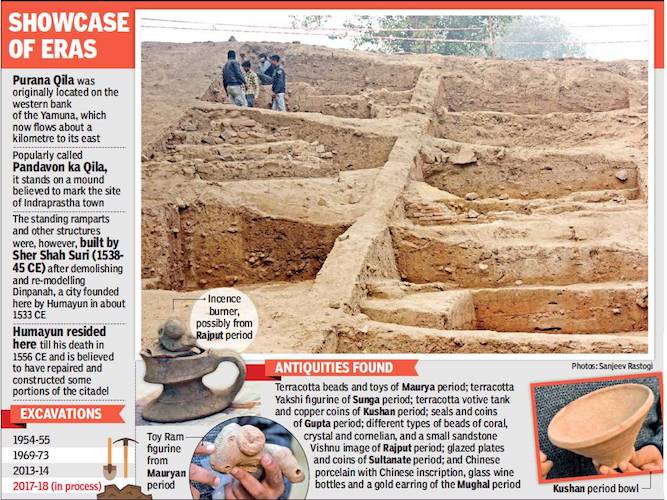
ii) previous excavations;
iii) antiquities found
From: Richi Verma, At Purana Qila, a hunt for Pandavas’ capital, December 21, 2017: The Times of India
ASI Begins Excavation Near Sher Mandal To Find Deposits That May Link Citadel With Mahabharata Era
Purana Qila’s link with the Mahabharata has always been conjectured about, but it is only now that there’s an archaeological effort to determine if there is a connection between the popular monument and Indraprastha, the capital of the Pandavas in the epic. The Archaeological Survey of India has begun excavating near Sher Mandal in the old fort in the hope of finding stratified deposits of painted grey ware (PGW) that can prove the citadel was inhabited during the Mahabharata era.
Three excavations have been carried out in Purana Qila in the last 40 years, during which a number of antiquities, including terracotta beads and toys of the Mauryan years, terracotta Yakshi figurines of the Sunga era, terracotta votive tanks and copper coins of the Kushan period, seals and coins of the Gupta period, different types of beads of coral, crystal and carnelian, glazed plates and coins of the sultanate eras and Chinese porcelain, glass wine bottles and a gold earring of the Mughal years were unearthed.
So far, the oldest artefacts found in Purana Qila are of Mauryan origin from around 300 BCE. “There were some shards found in the outer area of Purana Qila in the 1960s that showing evidence of PGW. But our mission now is to find stratigraphic deposits of that period,” asserted Vasant Kumar Swarnkar, ASI superintending archaeologist, who is overseeing the current excavation.
Experts correlate the PWG culture in India with the Mahabharata period. And since Purana Qila is known as the site of Indraprastha, ASI officials argued that stratigraphic findings of PGW would establish the relation of the site with the epic. “We already have evidence of the site’s existence in the Mauryan period and are now looking for indication of life before that,” said one of the officials. Like the PGW pottery shards found three years ago, they hope to find strata of PWG deposits now.
Two trenches have been dug up near Sher Mandal, and a third trench has been earmarked for excavation. The project started a week ago and will take a few months before any new findings are confirmed. “Right now, we have only gone about one and a half feet deep, but the plan is to go down to around four feet below ground level,” explained an ASI official.
Among the antiquities discovered during the new excavations are coins, some bowls and a toy ram figurine that has stamp impressions showing signs of being from the Mauryan period. “Most of what has been found are items of everyday, routine life from different periods ranging from 300 BCE to 5th century CE,” pointed out one official. A Mauryan period ringwell discovered in 2013-14 will be further excavated.
ASI also hopes to have the excavations opened for public viewing within six months. “The excavations of the 1960s and 2013-14 have been exposed for public view. These excavations will be conserved with the help of old drawings and photographs from our archives,” said an ASI official.
The archaeological body have covered the earlier excavations and erected glass displays around them to ensure their protection while allowing the public to see them. Special pathways are planned so visitors can walk around and see the deposits from different periods as and when they were discovered. “This will be the only site in Delhi to showcase such excavations,” said an official.
Sher Shah Gate
Damage in 2012
Broken Lal Darwaza not fixed in 2 yrs
Richi Verma The Times of India Jan 05 2015
In August 2012, a sizable portion of the 16thcentury Sher Shah Gate, a monument located in central Delhi, collapsed due to heavy rainfall. Many experts say the delay in conserving the gateway has led to new cracks on the facade which poses a danger to visitors.
Located opposite Purana Qila, Lal Darwaza was constructed by Sher Shah Suri, who had conquered Delhi after defeating Mughal emperor Humayun. The collapse occurred on August 21 when the city had the highest rainfall of that season. Inspections revealed that stone blocks in the lower portion had also got displaced.
When the collapse took place, the age of the structure and pressure of heavy rain on it was blamed. “The monument is hundreds of years old and it appears that the effect of lime mortar, which acted as a binding agent, weakened it over time.The portions collapsed after additional pressure of the rain,“ said a source.
The overall structure of the monument also became weak due to the displacement of stone slabs in the lower portion.
Sher Mandal
A monument of beauty, learning and tragedy
Baishali Adak, April 2, 2014, DHNS:
Death calls out to each person in a different way. To Humayun, it was, literally, a call from the Almighty himself.
Hearing the call of the muezzin for the evening namaaz, emanating from the nearby Qila-i-Kuhna Mosque, Humayun rushed down his library-cum-astronomical observatory Sher Mandal.
He slipped, fell headlong down the steep stairs and died within three days of receiving the fatal wounds.
That is how the second emperor in the line of the illustrious Mughal empire - Nasir ud-din Muhammad Humayun – met his end.
Sher Mandal – the garden pavilion located south of Purana Qila (home to Humayun those days) – however, stands in all its glorious beauty and historical significance till date.
If you have seen a good number of Mughal monuments before – with their typical red sandstone structure and pointed arches – you’ll easily be able to tell that Sher Mandal is different.
Visibly, it was built with a measure of taste and elegance.
The double-storeyed octagonal structure, though made of sandstone, is punctuated with strips of marble.
The pointed arches on the upper floor are enhanced by an outline of marble inlay work and Islamic star symbols on both sides.
The ‘stellar’ marble work on the foot of the pillars, inside of the arches and ceiling of the domes also commands attention. Lending a Rajput feel to the Mughal piece of architecture are the ornamental eaves (chhajja) running along the edge of the roof and the beautiful canopy (chhattri) – the crowning glory of Sher Mandal.
While the niches on the lower floor are closed, except for one, those on the upper floor are connected around a central chamber to form a breezy verandah.
Historians dispute over who could have commissioned Sher Mandal originally.
Some accounts say Humayun ordered it on the highest point of the fort complex as an observatory-cum-library, and that construction was stopped for 15 years following his defeat and ouster at the hands of Afghan king Sher Shah Suri.
Some other references attribute it to Suri himself, who had a good sense of architecture and administration, and built the garden pavilion as the fort’s new owner in 1541 AD.
The latter seems to be a more credible explanation as the structure still carries the Afghan king’s name – Sher Mandal. What is certain is that Humayun, after he regained the throne, became so fond of ‘Sher Mandal’ that he would spend a major part of his day here.
Only the second astronomical observatory in Delhi (the first being Firoz Shah Tughlaq’s 14th century facility in Pir Ghaib), Humayun spent many nights here gazing at the stars.
His valuable manuscripts were stocked here, evidence of which can still be seen in traces of stone-shelving inside.
Poetic seminars with participation from the most learned men were held here, and this is where Mir Sayyid Ali taught drawing to both son and father - Akbar and Humayun. On January 24, 1556, Humayun fell from its stairs to his death, Akbar eventually moved his Capital to Agra and Sher Mandal of Purana Qila lost its royal sheen.
For all the times and tragedy it has seen, though, Sher Mandal stands as a testimony to history.


